The first painting you see at the James Rosenquist retrospective at the Guggenheim in New York until 25 January is President Elect: a broad headshot of a beaming JFK, manicured fingers with a piece of cake, and the sleek side of a pale green sedan. A collage study reveals the sources to be a campaign poster and two magazine ads; cropped and gridded, then painted on canvas, the images promise good times ahead: a youthful President, a skilful housewife (moist cake was the ultimate test), a nice car. A hint of a rainbow even connects the pieces of the paradise.
Yet not all is well. Kennedy appears flushed (a blood red also appears in the ground of the painting and in the hub of the car), and the female fingers protrude, grotesquely, out of his head. All the promises are for sale only, and the goods are near or past expiration: the cake is grey, beyond stale, and the car, a 1949 Chevrolet, is a faded desire. A glance at the date of the painting – 1960-61/1964 – reveals that its making straddled the JFK assassination, forty years ago last month. Suddenly the dream – and it is a collective dream that Rosenquist, a sign-painter from the Midwest, presents here, right down to its broken rebus logic – becomes dark: the sedan suggests the fateful limousine in Dallas, the cake fragments evoke the exploded brains of the President and the headshot turns into a bad joke. Of course the Kennedy myth crumbled a long time ago; the extraordinary thing is that Rosenquist could paint the myth yet point to its failure, and do so in the original moment.
Like J.G. Ballard in the 1960s, Rosenquist was a Pop Surrealist: he addresses the Pop themes of consumer society by means of a Surrealist form of painted collage that recalls Freudian dream-work, but a dream-work now let loose in the world. Adapted to a grand scale (in the late 1950s Rosenquist worked on billboards in New York), this technique enabled him, as a young artist, to capture, like no other figure except Warhol, both the glamorous veneer and the nasty underbelly of the spectacle. Occasionally Rosenquist is too literal about this dark side – a few early paintings opt easily for a noir atmosphere or a grisaille deathliness – and the juxtapositions often strain for effect. Many pictures unfold like ‘exquisite corpses’, but without the frame of the human body to hold the unexpected parts together. Sometimes, however, the method works: I Love You with My Ford (1961) presents up-close slices of a Ford grill, the commingled faces of two lovers and a mess of orange spaghetti (this industrial food appears in several paintings like spilled guts). In a Pop move pioneered by Eduardo Paolozzi and Richard Hamilton, Rosenquist juxtaposes various bodies as if to imply that different fetishisms, sexual and commercial, have merged in postwar culture. He captures in paint a new imagistic version of the old capitalist condition in which the human appears suddenly reified and the inhuman strangely alive.
With his image fragments and scale jumps Rosenquist disrupts the unities of both traditional painting and commercial design, yet this disruption is time-sensitive: just as Surrealist collage was appropriated by advertising for its own ends, so advertising took back in stylistic devices what it gave Pop in source materials. Perhaps this loop between art and advert is what drove Rosenquist to make his image combinations ever more various; as a result, however, some of his juxtapositions from the 1980s and 1990s are random and anodyne. These works inadvertently play into a Pop topos that Rosenquist otherwise resists: ‘the waning of affect’ that Warhol and other cool Pops are said to register. In recent years Rosenquist has featured floral motifs, inspired by the Florida setting of his studio, intercut with feminine faces and astral backgrounds, as though to suggest a splicing, at once genetic and cosmic, that goes well beyond the interfaces explored in his early work. His latest paintings present lush fields of metallic motifs that conjure up what cyberspace might look like – that is, if it could be represented at all (a kid next to me at the show dubbed them ‘very Matrixy’).
This dizzy blending of forms is as important to the Rosenquist effect as his abrupt juxtaposing of images. It is by means of his suspension of disparate shapes in the same surface that he points to what every Pop artist worthy of the name indicates: that the postwar world of appearance had become mediated, as though already screened, with the gloss of magazines, the flow of television, the scale of billboards or the sweep of movies. It is this photographic semblance that allows Rosenquist to compare a female face with a tomato skin in one early painting and a Coca-Cola bottle in another. In this post-natural world all lines are designed, all colours are plastic, and the last place to look for the organic is the human body: in Rosenquist, teeth possess a sadistic cleanliness, and legs are those of hairless mannequins. This is the look of reification (a term in his own lexicon) in the world of Pop: at once fragmentary and fluid, imagistic and abstract.
His summa is F-111 (1964-65), a history painting of the US during the Vietnam War. Named after a fighter jet developed at colossal expense, this immense (86-foot long) painting surrounds the viewer with its dark dreams. Along the body of the jet Rosenquist introduces images: wallpaper, a tyre, a cake, a light bulb, an umbrella, an atomic cloud, an exploded figure in a flight suit and spaghetti. Near the centre, under a silver hairdryer, is a little blonde girl with a demonic smile (those teeth again), an impossible combination of Shirley Temple and Darth Vadar. A collage study identifies her as the pilot of the jet: in some sense the war is waged not only for her but by her as well. And in the pictorial conflation of hairdryer and helmet Rosenquist condenses a political connection between consumer affluence and the ‘military-industrial complex’ (which Eisenhower warned against as Kennedy assumed power). Across the same study Rosenquist scrawled ‘Death and Taxes’, as in the saying about the only sure things in life: here taxes support the military production of death abroad, and this in turn floats the middle-class lifestyle of consumers at home. He also wrote ‘Vanity’, and the painting does suggest not only a murderous self-absorption but a collective vanitas, a reminder of death – literal abroad, moral Stateside. It is enough to remind you of the present.
Send Letters To:
The Editor
London Review of Books,
28 Little Russell Street
London, WC1A 2HN
letters@lrb.co.uk
Please include name, address, and a telephone number.


